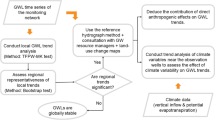Abstract
Induced sinkholes (catastrophic subsidence) are those caused or accelerated by human activities These sinkholes commonly result from a water level decline due to pumpage Construction activities in a cone of depression greatly increases the likelihood of sinkhole occurrence Almost all occur where cavities develop in unconsolidated deposits overlying solution openings in carbonate rocks. Triggering mechanisms resulting from water level declines are (1) loss of buoyant support of the water, (2) increased gradient and water velocity, (3) water-level fluctuations, and (4) induced recharge Construction activities triggering sinkhole development include ditching, removing overburden, drilling, movement of heavy equipment, blasting and the diversion and impoundment of drainage Triggering mechanisms include piping, saturation, and loading
Induced sinkholes resulting from human water development/management activities are most predictable in a youthful karst area impacted by groundwater withdrawals Shape, depth, and timing of catastrophic subsidence can be predicted in general terms
Remote sensing techniques are used in prediction of locations of catastrophic subsidence. This provides a basis for design and relocation of structures such as a gas pipeline, dam, or building Utilization of techniques and a case history of the relocation of a pipeline are described
Similar content being viewed by others
References Cited
Aley, T. J., J. H. Williams, J. W. Masselo, 1972, Groundwater contamination and sinkhole collapse induced by leaky impoundments in soluble rock terrance: Missouri Geological Survey and Water Resources Engineering Geology Series no. 5, 32 p.
Butts, Charles, 1940, Description of the Montevallo and Columbiana Quadrangles (Alabama): U.S Geological Survey Atlas Folio 226.
Foose, R. M., 1953, Ground water behavior in the Hershey Valley, Pennsylvania: Geol. Soc. Amer. Bull., v. 64, p. 623–645.
LaMoreaux, P. E. B. M. Wilson, B. A. Memon, eds., 1984, Guide to the hydrology of carbonate rocks: UNESCO, 354 p.
LaMoreaux, P. E. and Associates, Inc. 1982: Unpublished reports to the Southern Natural Gas Company, Tuscaloosa, Alabama.
Lattman, L. H., R. R. Parizek, 1964, Relationship between fracture traces and the, occurrence of ground water in carbonate rocks. J. Hydrol., v. 2, p. 73–91.
Newton, J. G., 1976, Early detection and correction, of sinkhole problems in Alabama, with a preliminary evaluation of remote sensing applications: Alabama Highway Department, Bureau Research and Development, Research Report no. HPR-76, 83 p.
Newton, J. G., 1984, Natural and induced sinkhole development—eastern United States: International Association of Hydrological Sciences Proceedings, Third International Symposium on Land Subsidence, Venice, Italy (in press).
Newton, J. G., L. W. Hyde, 1971, Sinkhole problem in and near Roberts Industrial Subdivision, Birmingham, Alabama—a reconnaissance: Alabama Geological Survey Circular 68, 42 p.
Newton, J. G., C. W. Copeland, L. W. Scarbrough, 1973, Sinkhole problem along proposed route of Interstate 459 near Greenwood, Alabama: Alabama Geological Survey Circular 83, 53 p.
Powell, W. J., C. W. Copeland, J. A. Drahovzal, 1970, Delineation of linear features and application to reservoir engineering using Apollo 9 multispectral photography: Alabama Geological Survey Information Series 41, 37 p.
Powell, W. J., P. E. LaMoreaux, 1960, A problem of subsidence in a limestone terrane at Columbiana, Alabama: Alabama Geological Survey Circular 56, 30 p.
Robinson, W. H., J. B. Ivey, G. A. Billingsley, 1953, Water supply of the Birmingham area, Alabama: U.S. Geological Survey Circular 254, 53 p.
Sabins, F. F., Jr., 1978, Remote sensing: San Francisco, W. H. Freeman, 426 p.
Shourong, Shu, 1982. The coincident spectral plot method for selecting the remote sensing bands of carbonate rocks: Carsologica Sinica, v. 1, no. 2, p. 158–166.
Sinclair, W. C., 1982 Sinkhole development resulting from ground-water withdrawal in the Tampa area, Florida: U.S. Geological Survey Water Resources Investigations 81-50, 19 p.
Spigner, B. C., 1978, Land surface collapse and ground-water problems in the Jamestown area, Berkley County, South Carolina: South Carolina Water Resources Commission Open-File Report no. 78-1, 99 p.
Warren, W. M., 1974, Retention basin failures in carbonate terranes. Water Res. Bull., v. 10, no. 1, p. 22–31.
Warren, W. M., 1976, Sinkhole occurrences in western Shelby County, Alabama: Alabama Geological Survey Circular 101, 45 p.
Author information
Authors and Affiliations
Rights and permissions
About this article
Cite this article
Lamoreaux, P.E., Newton, J.G. Catastrophic subsidence: An environmental hazard, shelby county, Alabama. Environ. Geol. Water Sci 8, 25–40 (1986). https://doi.org/10.1007/BF02525556
Issue Date:
DOI: https://doi.org/10.1007/BF02525556




